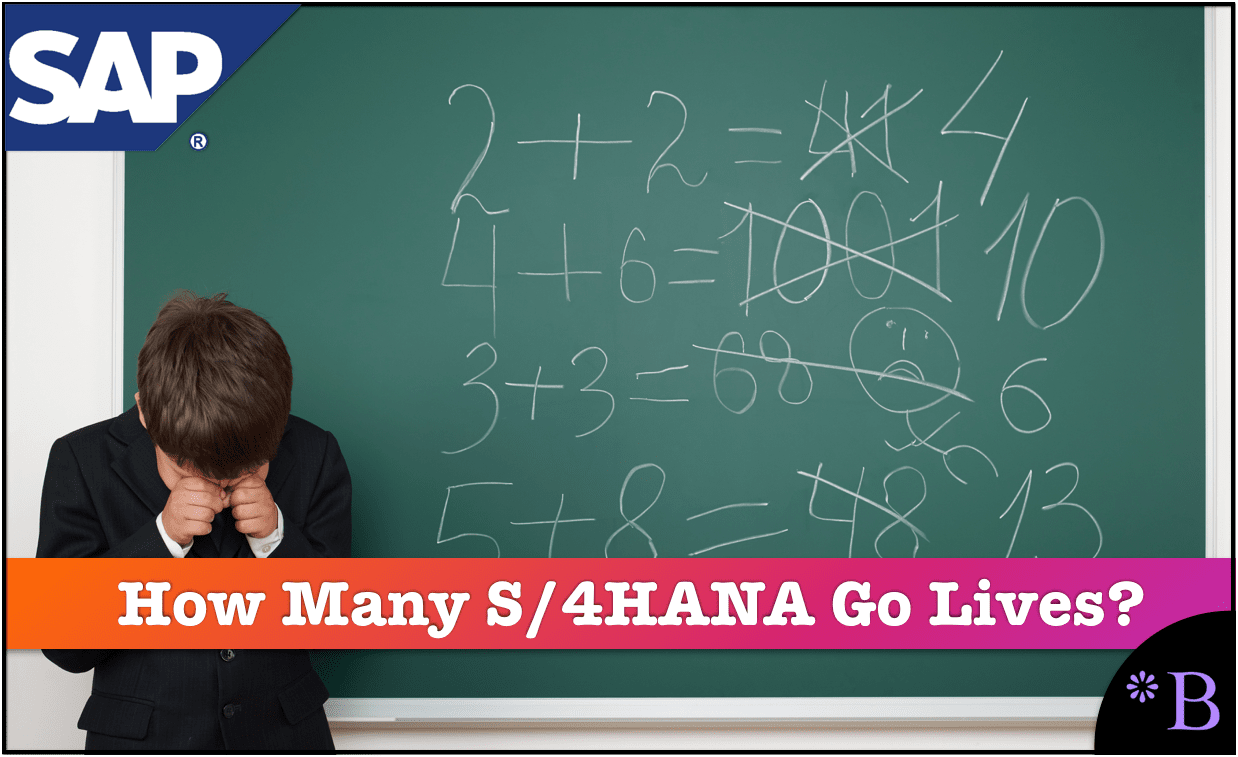Brightwork 2019 Update: How Many Live SOH and S/4HANA Customers Are There?
Executive Summary
- SAP has proposed 3500 go-lives for S/4HANA. What SAP says is usually repeated by those that cover SAP.
- What is the reality of the S/4HANA go-lives in 2019?

Introduction
We have been tracking S/4HANA numbers for roughly three years. We covered this of live S/4HANA customers in 2017 in The S/4HANA Implementation Study, and in 2018 we covered this topic, How Accurate Was SAP on S/4HANA’s Go Live Numbers? We decided to write this article to update readers as to the background for our current estimate for 2019, or at least for mid-2019.
Our References for This Article
If you want to see our references for this article and other related Brightwork articles, see this link.
Notice of Lack of Financial Bias: We have no financial ties to SAP or any other entity mentioned in this article.
Taking the AOK Hessen S/4HANA Case Study as an Example
When a case study is published, information is communicated that SAP and the customer and implementation partner did not want critically analyzed.
This is an excellent example of the issues with some of the S/4HANA case studies.
AOK Hessen is an insurance company. They stated that they implemented performance management and financial accounting. They indicated that they integrated the
“SAP HANA in-memory database and data structures tailored to this technology, applications can leverage their full potential and achieve significant speed advantages.”
We know that part of this is untrue and that AOK would have seen a performance decline for transactions, which is, of course, most of what S/4HANA does, as we covered in the article HANA a Mismatch for S/4HANA and ERP.
They also stated with S/4HANA, they took
“A big step in digitization and in our fields of action Automation, Simplification and Big Data Management.” For future S/4HANA applications,”
This would not have happened, and HANA is not simplified, and S/4HANA has nothing to do with Big Data Management. This is a common feature of S/4HANA go-lives. They have a strong tendency to refer to things that are not within the domain of ERP or that don’t come as part of S/4HANA. AOK Hessen goes on to make this claim around Fiori.
“SAP Fiori will be used. Fiori enables ergonomic and reduced-click user interfaces, which greatly accelerate the processing of mass processes and make them more efficient. In conjunction with intelligent regulations and process automation, it is possible to process insured claims more quickly.”
First, why is this statement in the future tense? If the system is live, it would be Fiori is used. Furthermore, there is no evidence that Fiori allows users to process transactions faster than SAPGUI. User testing often shows that Fiori slows the process versus SAPGUI.
- One question that comes to mind is why it sounds like SAP wrote this case study, AOK Hessen, or AOK Hessen being coached by SAP. If a case study includes talking points from SAP marketing that are known not to be part of the system’s reality, then the independence of the company from the influence of SAP can be questioned.
- But secondly, this shows a common feature of S/4HANA implementations that they tend to not be in manufacturing or distribution companies — which is the core of ECC’s customer base. The primary logic for ERP (that it ties together finance, sales, production, and materials management) This case study does not prove that the S/4HANA suite is ready because AOK Systems would have implemented only a small part of it.
The Swiss Property S/4HANA Example

SAP is very good at making glossy case studies like this. Swiss Property is a small company that appears to have been given some incentive to “implement” S/4HANA, and their business processes not only do not map to S/4HANA, but they also don’t map to ERP.
The Typical Technique for Analyzing S/4HANA
Every article we have read on S/4HANA implementations, a specific case study assumes that everything published in the case study and every number reported by SAP is true. This ignores the fact that the primary reason information is released about S/4HANA is to promote S/4HANA, HANA, and related consulting services. The only releases of information contradict this when a S/4HANA project goes south and information leaks out. And even here, the information is typically highly censored, with the customer states that there has been just a “brief hiccup,” and soon, the project will be back on track.
S/4HANA Paid Research Benefits
| Benefits | Description |
|---|---|
| Accuracy | The most accurate information on S/4HANA implementations anywhere entirely devoid of any SAP influence. |
| Detailed Analysis | Detailed analysis of cost to two hundred S/4HANA case studies. Insights not available anywhere else with competitive intelligence, buyer and investment implications. |
| Based in SAP Project Domain Expertise | Conclusions based upon a combination of the case studies along with expertise in S/4HANA and SAP implementations to determine fact from marketing hyperbole. |
| The Fit of S/4HANA to Clients | An analysis of the fit between S/4HANA and each implementation. |
| Sales Evidence for Prospects | The ability to share the research with prospects. (each prospect requires a separate use license) |
Who you use to obtain information about S/4HANA is of critical importance. The following table tells you about us and what makes our research different.
How Our Technique Differs from Other Reporting on S/4HANA Numbers
| Cost Description | Cost Category | Estimated Multiple or Fraction | Traditional Cost as a % of Total Cost |
|---|---|---|---|
| Total Hardware Multiple | 2.5 | 7% | |
| DC Impacts, Significant Additional Power, Cooling, Space, + Any Drag Along ("per core licenses" for backup/recovery, monitoring, scheduling, etc) | Hardware | 2 | |
| Inefficient use of Non-Commodity H/W Resources - Cores, GB Ram, lots of SAP TDI based storage (X5 for Logs (x1) | Hardware | 3 | |
| Non-Commodity Hardware/Appliance Costs, Refresh Cycles (Very Spiky, Peaky Utilization) | Hardware | 3 | |
| Average Implementation Multiple | 2.15 | 60% | |
| Complexity of "Multiple" Database Building Blocks "Commodity" Hardware/Appliance Costs, Refresh Cycles (Very Spiky, Peaky Utilization) | Maintenance | 1.8 | |
| Frequency of SAP HANA Database Patches, Version Upgrades | Maintenance | 2.5 | |
| Average Implementation Multiple | 2.75 | 20% | |
| Complexity of Getting the Sizing Right (in particular, if user or data growth rates are unknown vs. any prior pattern) | Implementation | 3 | |
| Required Data Archiving, House Keeping, Clean Up | Implementation | 3 | |
| General HANA Implementation Costs | Implementation | 2.5 | |
| Changed Table / Data Structures + need to check, confirm availability of add-on's | Implementation | 2.5 | |
| Average Software Multiple or Fraction | 1.7 | 13% | |
| Purchase Price | Software | 1.7 |